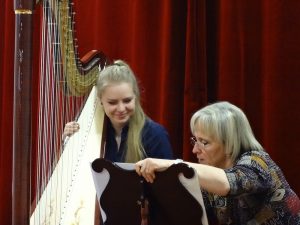Camac Blog
Countdown to Belfort and talking with…Patrizia Tassini
News
September 26, 2018
The Camac Festival will soon be heading for Belfort – and to whet your appetite even more than our snazzy publicity materials already have done, we’ll be blogging some more about our programme over the next few days.
The Belfort long weekend will begin with distinguished Italian harpist Patrizia Tassini. Patrizia is Professor of Harp at the Conservatorio “J.Tomadini” in Udine, and also directs Ventaglio d’arpe, a big student harp ensemble. Her curriculum includes the silver medal in Israel, and gold at the Second International Harp Competition in Varallo. Today, she sits on competition jurys throughout the world, for example in Israel, Bloomington, at the Paris Conservatoire, at the Concours Félix Godefroid in Tournai, Belgrade, the Concours Martine Géliot, etc. She has been a member of the Board of Directors of the World Harp Congress, and recently has given concerts and masterclasses throughout Europe, in China, Taiwan and Turkey.
“After eight years of harp lessons in Italy with the excellent teacher Evelina Vio, I applied to the Conservatoire National Superieur in Lyon. This wasn’t a big plunge into another way of working: Elisabeth Fontane-Binoche and Germaine Lorenzini continued to work on technique in order to bring out musicality, giving particular importance to a proper articulation. When the academic year was over, and straight after I won second prize at the International Harp Contest in Israel, I got a scholarship to work with Eileen Malone at Eastman School of Music. Here, I continued with the technique that is variously described as “French school” or “Grandjany”, but we always took care of stylistic interpretation by looking at the the texts of the different composers. My experience of the so-called Italian, French and American schools of harp playing was not one of big differences, but rather a shared project to deepen and perfect my musicianship.
The harp scene is even more global today, and the technical differences in harp teaching are getting smaller all the time. Harpists agree more and more on hand position, about pressure on the strings for a good sound…the mobility and communication we all have today makes it easier for us to find out about teachers all over the world, watch what they do and apply it to ourselves or to our students. This is good for the level, of course, the level goes up all the time.
In Udine, besides harp lessons, my students take both music and harp history classes. It’s important to understand both the instrument, and the different composers who write for it, for a good stylistic interpretation. I also think it’s very important for harpists to do chamber music even from a very young age, so that listening to other instruments and breathing with them becomes second nature. Also, the ear has to get used to the sound of the orchestra, and you have to learn how to follow a conductor. But orchestra can be difficult for young harpists, because they are alone, nobody else understands their instrument, and they don’t play all the time. My harp orchestra Ventaglio d’arpe is for all my students aged between eleven and thirty, so that they can experience performing together, and also have fun! Everybody plays, whether on an easy or a difficult part, and we are a group, both musically and socially. By working together with different levels, students can set themselves goals for the future, in a supportive atmosphere without any envy or jealousy.”


